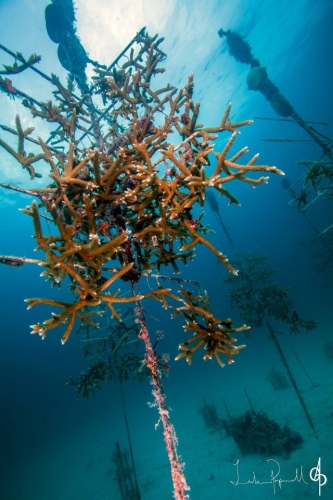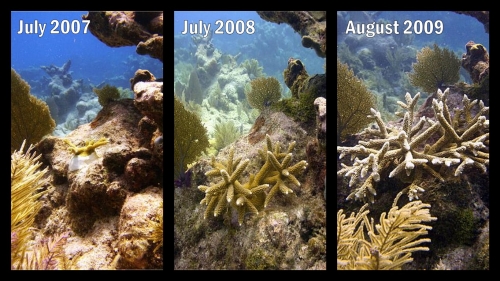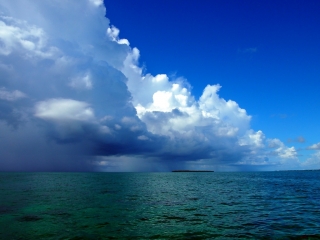The OWUSS family gets bigger and bigger each year with new scholars, interns, hosts and friends. This network and these connections are what make the experience so incredible. While in Key Largo, Florida I had the opportunity to meet former REEF Intern Stephanie Roach and work with her on her new project. Since finishing her OWUSS internship Stephanie was hired as the Science and Education Director of the Coral Restoration Foundation. I joined CRF for a day of diving while in Key Largo.
Staghorn Coral, (Acropora cervicornis), is one of the predominant “reef building” corals of the Caribbean and has declined dramatically since the late 1970s. In the 1980’s the Federal Register listed declines of up to 96%. Today this species and its close relative elkhorn coral (A. palmata) are listed as endangered species. Cumulative events, such as disease outbreak(s), cold fronts, and the loss of the long-spined sea urchins were significant contributors to the great decline of this Caribbean coral. In addition, corals face various direct and indirect pressures from human activity, such as rising green house gases, overfishing, vessel groundings and coastal development. Since coral provided habitat (hiding holes and homes) and food for many reef organisms, the whole reef community has been drastically impacted with these losses. CRF is working to reestablish healthy populations of these corals throughout Florida and the Caribbean.
I have loved asking hosts throughout the year how they became involved in the work they love. CRF has one of my favorite stories to date! CRF was founded by Ken Nedimyer in 1996. Ken’s background is in aquarium fish collecting and he cultured live rock as part of his business. Over the years he noticed staghorn coral starting to volunteer on some of his rocks. Around the same time Ken’s daughter, Julie, was brainstorming for a 4-H project. This Daddy-daughter team began to nurture these small recruits and found success growing them larger and larger. By 2003, Ken realized that the corals he was growing could be re-planted and used to restore degraded reefs, so he approached the Florida Keys National Marine Sanctuary (FKNMS) with a proposal to transplant some as a trial. Ken was allowed to transplant a few corals to a site at Molasses Reef (site of the Wellwood ship grounding) where the reef had been destroyed. By the summer of 2011, after eight years of repairing and replanting broken pieces from his original six corals, there were over 3,000 coral colonies growing at the north end of Molasses Reef. In the past four years, dozens of those new colonies have even spawned! The success of the Molasses reef experiment convinced Ken that reef restoration was possible on a large scale throughout Florida, the Caribbean, and the world. From a humble 4H project grew the nursery, restoration foundation, and success that reef restoration is possible on a large scale for Florida and the greater Caribbean.
When swimming over a coral reef, it’s common to find small pieces of coral broken off from a colony and rolling around on the bottom. Broken chunks come from storm waves, careless divers or any number of other disturbances. Disconnected from the whole colony these pieces would normally get covered by sand, smothered by algae, or shaded until all the polyps died. When CRF finds one of these pieces, in their terms a ‘fragment of opportunity’, it has a new chance at life in their nursery. All of their nursery corals have been found this way or fragmented from another wild collected coral.
My first stop of the day was diving at the CRF coral nursery. The nursery sits in 30 feet of water a few miles offshore of Key Largo. Growing coral for outplanting on this large scale has been largely experimental for the CRF team. Swimming through the nursery is a tour of conservation strategy success. Coral fragments were originally wired onto plastic disks on top of rebar spikes pounded deep into the sand. Many tired arms and sore shoulders later, CRF realized that disks are a prime platform for many other things (algae, worms, etc) to grow. Each interaction with disk hitchhikers reduced the growth of the coral. Fighting fouling meant scrubbing all the disks, all the time. The next evolution involved hanging fragments from lines like drying clothes. While a significant improvement from scrubbing, as corals grew they would get heavier and sag to the middle knocking into one another. The pièce de résistance of the nursery are now the coral trees—imagine a 6 foot tall coral mobile! Wired dangling below radiating bars, staghorn fragments are free to grow unencumbered, suspension feeding as mid-water currents move past them. These coral trees have vastly increased the number of corals the nursery can support and rocketed up potential for major outplanting and restoration.
CRF has approximately 26,000 staghorn fragments in the nursery along with 1,000 elkhorn fragments. Staghorn are a fast-growing species (for the coral world) and will grow about 8 inches in a year. During my visit we transferred 80 fully grown nursery corals ready to rejoin the coral reef. Ken, Stephanie and I gathered several genotypes of different trees and headed out to Molasses Reef, one of Key Largo’s prime habitats for coral. You can still find several large, live elkhorn coral colonies here making it a popular spot for dive and snorkel boats. Molasses also has lots of great habitat for new staghorn colonies. In the last 90 days CRF has outplanted 1200 staghorn corals to Florida reefs. By the end of 2012 they will have placed about 8000 more!
Corals are randomly distributed on the reef in large oval shapes. Each coral will sit 3-4 feet apart from each other and is likely to have a genetically varied neighbor due to the randomization. The oval shape keeps corals near others which increases success when they begin to spawn. Corals are then cemented down to the reef with putty cement and an identification tag is mounted next to the fragment for future monitoring. Check out this coral’s progression!
It’s an exciting opportunity to work on a specifically conservation-based project with completely tangible daily contributions to coral restoration. After a day of hard work, it was gratifying to climb in the boat knowing nearly 100 new coral colonies were taking root thanks to the team’s efforts. CRF has taken their success global and are also restoring reefs in Bonaire and Columbia. More sites are in the works and I can’t help but feel optimistic about staghorn coral’s future success in these regions.
If you’re looking for a way to help coral reefs or you need an AWESOME gift idea, consider adopting a coral from CRF! Your money returns to CRF to support the nursery and help restore coral reef ecosystems. You can personally be part of securing the health of our reefs for future generations. I think my friends and family know what they’re getting for Christmas! 🙂











I really enjoyed reading this post Megan. What a great project! I am living vicariously through your blogs, keep up the good work!
Thank you for your kind note! I love hearing that you’re enjoying reading along. Please encourage your roommate to check out this blog, and follow the whole adventure. I’m happy to answer questions as I travel too; please let me know what you want to know about our oceans.